Stillwater Reports Multiple Large-Scale Polymetallic Magmatic Sulphide Targets From 2024 Geophysical Surveys in Montana’s Historic Stillwater Mining District
VANCOUVER, BC / ACCESS Newswire / March 26, 2025 / Stillwater Critical Minerals Corp. (TSXV:PGE)(OTCQB:PGEZF)(FSE:J0G) (the “Company” or “Stillwater”) is pleased to report multiple large-scale magmatic sulphide targets generated from a property-wide MobileMTm magneto-telluric (“MMT”) geophysical survey completed in late 2024 by Expert Geophysics Limited at its flagship Stillwater West Ni-PGE-Cu-Co + Au project in Montana, USA.
Data from the 2024 MMT survey was processed and incorporated into the Company’s 3D geological model of the lower Stillwater Igneous Complex to prioritize targets with a focus on expanding current mid- and high-grade mineral resources.
Highlights
- Inversion and 3D modeling of results from 2024 MMT geophysical surveys provide multiple coincident multi-kilometer-scale resistivity lows and conductive highs, as shown in the attached Figures.
- Magnetic inversion processing from the MMT data provides important information for project-wide structural interpretation and highlights relationships between the metasedimentary floor and ultramafic strata.
- Multiple very low frequency (“VLF”) data were also acquired, confirming near surface drilled mineralization and structures.
- Limited drill testing has been completed on these new targets to date. Where available, drill results confirm polymetallic sulphide-rich Platreef-style mineralization across wide areas of the project, as shown in Table 1, Pictures 2 and 3, and Figure 6.
- Results have expanded the detailed 3D geological model of the lower Stillwater Igneous Complex that has been developed by the Company from 9.5 kilometers to 20 kilometers, as shown in Figures 5 and 6.
- Results have provided multiple priority drill targets for expansion of mineral resources with particular focus on mid- and high-grade mineralization.
- Drill targets are now being finalized and prioritized for planned upcoming drill campaigns.
- The Company is working with Glencore plc via the Stillwater West technical committee, and ALS Global (formerly GoldSpot) to harness their cutting-edge Artificial Intelligence and Machine Learning technology and geoscience expertise.
Stillwater’s President and CEO, Michael Rowley, said “Having relied on globalized supply chains for decades, the United States has now made clear it intends to secure domestic inventories of, and processing capacity for, nine critical minerals that we have inventoried at Stillwater West. Last week’s Executive Order from the White House is the strongest directive yet in this regard, building on similar initiatives that date from 2016, and earlier. As the third largest mineralized layered magmatic complex in the world, the Stillwater Igneous Complex is famously well-mineralized and offers both scale and grade, making it a foundational component of this Government- mandated national policy objective. The Stillwater Igneous Complex has provided the United States with critical minerals for over a century, including the on-going production of palladium, platinum, rhodium, nickel, copper and other metals by our neighbor Sibanye-Stillwater. Our Stillwater West project covers the lower Stillwater Igneous Complex, invoking direct comparisons to the parallel geologic setting of Anglo American’s world-class Mogalakwena Mine, and Ivanhoe’s Platreef Mine, in South Africa’s Bushveld Igneous Complex. We are well positioned to bring these large, polymetallic mine models with robust economics to a similar geological setting in the United States. Following our recent meetings with State and Federal officials, we are focused on accelerating our path to mine development and production. We look forward to providing further updates and invite investors to meet the team at the upcoming shows listed below.”
Dr Danie Grobler, Stillwater’s Vice-President, Exploration, commented “The MMT electromagnetic, horizontal magnetic gradient, and TargetEM geophysical surveys performed by Expert Geophysics in late 2024 have imaged large coincident low resistivity, conductive and magnetic anomalies proximal to the footwall contact of the Stillwater Igneous Complex. As a result of uplifting during the Laramide tectonic event, these footwall targets can occur near surface, resulting in high quality drill targets that range in depth from shallow to over a kilometer or more. The most conductive anomalies are located proximal to the footwall contact and correspond with net- textured to massive sulphides, some of which have already been drill tested. For example, all six holes drilled during the 2023 exploration season intersected significant zones of net-textured to semi-massive sulphide within the Chrome Mountain area. The MMT results at Chrome Mountain display a large conductive anomaly extending from the historically drilled area towards the southeast along the footwall contact. A similar anomaly is imaged at Iron Mountain within the Camp Zone (CZ), HGR, and Crescent deposit areas. This particular anomaly is focused below Iron Mountain and is connected to the Camp Zone and Crescent deposit areas, extending at depth to around 1,500 meters below surface. The conductive anomaly displaces the highly magnetic anomalies of the Banded Iron Formation within floor rocks of the Stillwater Igneous Complex. Magmatic sulphide mineralization is known to extend below mafic-ultramafic intrusions either through a process of downward percolation or forming part of an intrusive feeder/conduit system. We look forward to drill testing these compelling targets with a focus on expanding our resources in the higher grade categories in particular in the upcoming planned campaign.”
Results of Property-Wide Airborne Geophysical Surveys
Stillwater contracted Expert Geophysics Limited to perform large-scale geophysical surveys with the objective of providing comprehensive coverage of the highly prospective lower Stillwater Igneous Complex. Particular focus was given to modeling mid- and high-grade mineralization for expansion of existing mineral resources in these categories in upcoming drill campaigns.
The surveys totaled 1,322 line-kilometers including test surveys over the Chrome Mountain resource area to compare the TargetEM26 time-domain electromagnetic (“EM”) survey with the MMT frequency-domain survey. Evaluation of these test surveys alongside the first generation DIGHEM airborne EM survey flown over the project in 2000, together with smaller surveys and extensive ground-based Induced Polarization and magnetic/VLF by the Company, resulted in the decision to fly the property-wide survey using the MMT system. The MMT system’s ability to better distinguish and define multiple conductive targets to greater depths, which is not terrain dependent, was confirmed as a result of the survey. An advanced generation of airborne AFMAG, or Audio-Frequency Magnetic, techniques, Expert’s MMT system combines the latest advances in electronics, airborne system design, and sophisticated signal processing techniques to use natural electromagnetic signals in the frequency range of 25 Hz – 21,000 Hz to map resistivity and conductivity in the earth below. Multiple VLF data were also acquired, confirming near surface drilled mineralization and structures.
The MMT surveys were completed in three grids, covering Chrome Mountain, Iron Mountain, and the Cathedral target areas at 100-meter line spacing, along with the Stillwater East claim block at 200-meter line spacing.
The surveys proved to be highly successful, with preliminary results enabling completion of the first-ever detailed 3D geological model of the lower Stillwater Igneous Complex. As announced October 16, 2024, that earlier version of the model made the important breakthrough of demonstrating continuity of mineralization across the central 9.5-kilometer length of layered magmatic stratigraphy which hosts the Company’s current resources in five deposits.
Recent analysis, including inversion work, has extended the modeled area to approximately 20 kilometers as shown in Figures 5 and 6, with strong electromagnetic anomalies indicated along the footwall contact zone of the Stillwater West project. These anomalies are consistent with the massive sulphide and contact-style nickel- copper sulphide-rich bodies that the Company is targeting, and form important Platreef- or contact-style targets for drill testing.
The high-resolution EM, magnetic, and VLF data provide detailed information about several different lithology contacts, faults, major structures, and conductive geology indicative of nickel-copper sulphide mineralization.
This new survey has provided higher resolution of known and unknown targets that occur near surface and now to a depth of 1.5 kilometers.
The data maps the nature of the footwall contact and corresponding country rock xenoliths, which act as favorable zones for sulphide trap sites. The lower peridotite contact was also well imaged, which hosts most of the current resources, and shows continuity along strike within all three survey grids covering over 34 kilometers (Figures 1 and 2). Magnetic inversion processing from the MMT data proved useful for project-wide structural interpretation and highlights relationships of the metasedimentary floor and ultramafic strata. Strike-extensive, highly magnetic susceptibility anomalies, attributed to the iron formation interbedded within the hornfels floor, served to improve modelling of the down-dip geometry of the footwall contact. This highly prospective floor contact zone forms the main exploration target for polymetallic mineralization across the 34-kilometer span of the Stillwater West project.
Most of the strongest conductive anomalies (< 250 ohm-m) have never been drill tested to date and continue along strike up to five kilometers in the Chrome Mountain area and up to seven kilometers in the Iron Mountain area. Both the Cathedral grid and the Stillwater East grid also have robust conductive anomalies (< 250 ohm-m) that are multiple kilometers in strike length.
Southeast trending, southwest dipping, strike-extensive low magnetic susceptibility anomalies correlate to Laramide fore-thrusts within the floor. The low magnetic signature of these structures is thought to be related to alteration and resultant de-magnetization of the metamorphosed metasedimentary rocks. In addition, isolated low magnetic susceptibility anomalies caused by xenoliths are noted within the lower units of the Peridotite zone. In places these are correlated to drill interceptions of hornfels and fine grained norite which, locally, is out of stratigraphic position. From the xenoliths intersected within drilling and following results from the 2024 MMT program, several anomalously low-magnetic xenoliths were modelled with the bulk of these occurring proximally to the footwall of the Peridotite zone, intermittently along strike.
Drill holes CM2023-04, CM2023-06, and CZ2021-01 are now recognized to be early drill tests of mineralization under hornfels xenoliths:
Table 1 – Past Drill Intercepts of 2025 Target Geophysical Anomalies
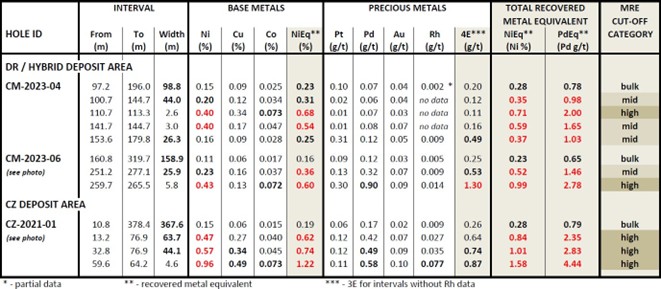
Highlighted significant intercepts with grade-thickness values over seven percent-meter recovered Nickel Equivalent (“NiEq”) are presented above, except as noted. Recovered NiEq are presented for comparative purposes using conservative long-term metal prices (all USD): $8.00/lb nickel (Ni), $4.00/lb copper (Cu), $22.00/lb cobalt (Co), $1,000/oz platinum (Pt), $1,950/oz palladium (Pd), $1,850/oz gold (Au), and $10,000/oz rhodium (Rh). NiEq is determined as follows: NiEq% = [Ni% x recovery] + [Cu% x recovery x Cu price/ Ni price] + [Co% x recovery x Co price / Ni price] + [Pt g/t x recovery / 31.103 x Pt price / Ni price / 2,204 x 100] + [Pd g/t x recovery / 31.103 x Pd price / Ni price / 2,204 x 100] + [Au g/t x recovery / 31.103 x Au price / Ni price / 2,204 x 100]. In the above calculations: 31.103 = grams per troy ounce, 2,204 = lbs per metric tonne, and 100 and 0.01 convert assay results reported in % and g/t. The following recoveries have been assumed for purposes of the above equivalent calculations: 85% for Ni and 90% for all other listed metals, based on recoveries at similar nearby operations. Total metal equivalent values include both base and precious metals. In terms of dollar value, 0.20% nickel equates to a copper value of 0.40%, or a palladium value of 0.48 g/t, using the above metal values. Intervals are reported as drilled widths and are believed to be representative of the actual width of mineralization.
Picture 1 – Drill hole CM-2023-06 – High-grade polymetallic sulphide mineralization from near the central portion of the robust 5-kilometer-long conductive anomaly (<250 ohm-m) in the Chrome Mountain deposit area, approximately five kilometers west of the Camp Zone (CZ) deposit and drill hole CZ-2021-01 shown in Picture 2.
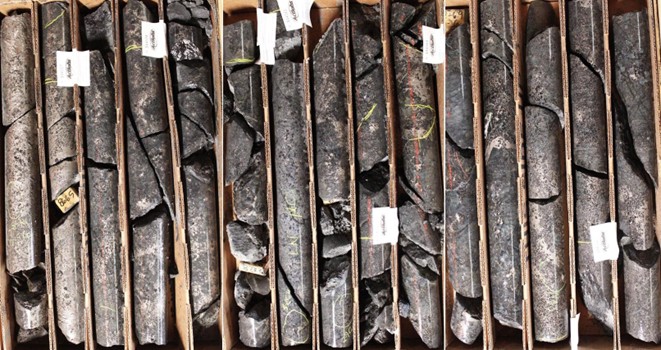
Interval of drill core from approximately 263 to 272 meters (864 to 892 feet) depth in hole CM-2023-06 showing high-grade nickel and copper sulphide mineralization in an early test of mineralization under hornfels xenoliths. As shown in Table 1, the hole returned a high-grade interval of 5.8 meters at 0.43% Ni, 0.13% Cu, 0.072% Co, plus 1.30 g/t 4E (0.30 g/t Pt, 0.90 g/t Pd, 0.014 g/t Rh, 0.09 g/t Au), within a 25.9-meter interval of mid-grade mineralization at 0.52% total recovered NiEq (0.23% Ni, 0.16% Cu, 0.037% Co, 0.13 g/t Pt, 0.32 g/t Pd, 0.07 g/t Au, 0.009 g/t Rh) which in turn is set within 158.9 meters of bulk tonnage grade mineralization of 0.23% total recovered NiEq (0.11% Ni, 0.06% Cu, 0.017% Co, 0.09 g/t Pt, 0.12 g/t Pd, 0.03 g/t Au, 0.005 g/t Rh), starting at 160.8 meters depth.
Updated Geological Model and Current Resource Estimate
The 2024 geophysical survey results have been incorporated into the 3D geological model. This new model advances the project as it is the first time the lower portion of the Stillwater Igneous Complex has been modeled in detail. This effectively connects the east and west ends of a large world-class district and providing a roadmap to expansion of the Company’s resources and advancement of the overall project, which is focused on the lower Stillwater Igneous Complex.
Continuity of mineralization across the entire surface expression of the magmatic layers of the Stillwater Igneous Complex has been demonstrated primarily by Sibanye-Stillwater’s J-M Reef deposit, a high-grade PGE-bearing nickel-copper sulphide deposit that spans more than 48 kilometers and supports the highest-grade palladium- platinum mines in the world. Stillwater’s current Inferred Mineral Resources of 1.6 billion pounds of nickel, copper and cobalt (1.1 Blbs Ni, 0.5 Blbs Cu, 0.09 Blbs Co), and 3.8 million ounces of palladium, platinum, rhodium, and gold (1.3 Moz Pt, 2.0 Moz Pd, 0.4 Moz Au, 0.1 Moz Rh)1 are hosted in five deposits that remain open for expansion along trend and at depth up to 20-kilometers at the center of the 61-square-kilometer Stillwater West project, which is adjacent to Sibanye-Stillwater along approximately 34 kilometers of strike within the Stillwater Igneous Complex.
Picture 2 – Drill hole CZ-2021-01 – High-grade polymetallic sulphide mineralization from the Camp Zone (CZ) deposit area, located on the western edge of the 7-kilometer-long robust (<250 ohm-m) conductive anomaly below Iron Mountain, approximately five kilometers east of the Chrome Mountain deposits and drill hole CM- 2023-06 shown in Picture 1.
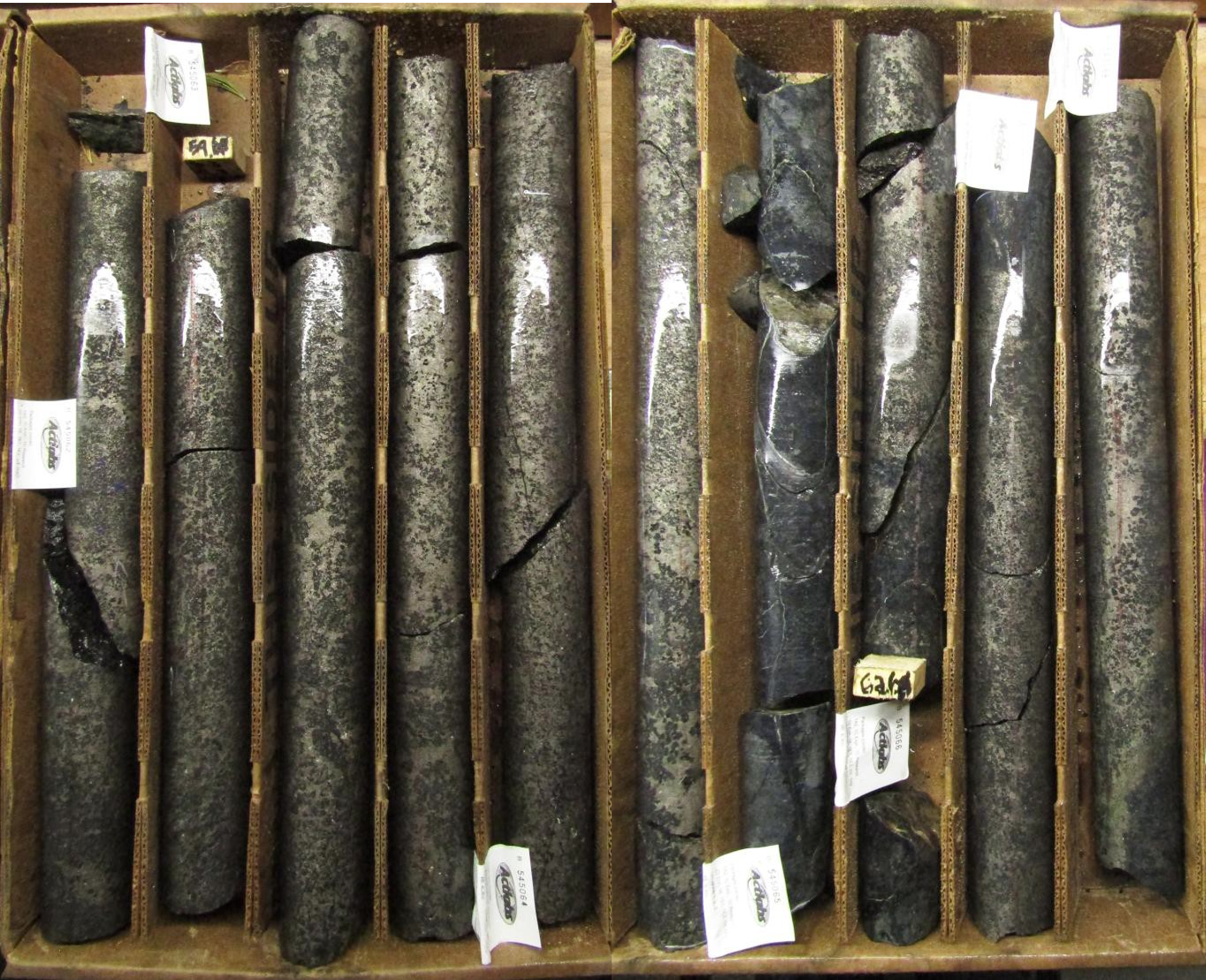
Interval of drill core from 56.0 to 63.6 meters (184 to 209 feet) depth in hole CZ-2021-01 showing high-grade nickel and copper sulphide mineralization in an early test of mineralization under hornfels xenoliths. As shown in Table 1, the hole returned a high-grade interval of 4.6 meters at 0.96% Ni, 0.49% Cu, 0.073% Co, plus 0.87 g/t 4E (0.11 g/t Pt, 0.58 g/t Pd, 0.10 g/t Au, 0.077 g/t Rh), within a longer 63.7-meter interval of high-grade mineralization at 0.84% total recovered NiEq (0.47% Ni, 0.27% Cu, 0.040% Co, 0.12 g/t Pt, 0.42 g/t Pd, 0.07 g/t Au, 0.027 g/t Rh), which in turn is set within 367.6 meters of bulk tonnage grade mineralization of 0.28% total recovered NiEq (0.15% Ni, 0.06% Cu, 0.015% Co, 0.06 g/t Pt, 0.17 g/t Pd, 0.02 g/t Au, 0.009 g/t Rh), starting at 10.8 meters depth.
Upcoming Events
Stillwater’s President and CEO, Michael Rowley, will be available at the following events in 2025, in addition to other events to be added as the Company rolls out its marketing plans over the coming year:
- SAFE Summit – Washington, DC, USA, Apr 1-2, 2025. For information, click here.
- Global Commodity Expo Florida – Fort Lauderdale, Florida, USA, May 11-13, 2025. For information, click here.
- Global Commodity Expo Atlanta – Atlanta, Georgia, USA, May 14-16, 2025. For information, click here.
- The Mining Investment Event of the North – Quebec City, Quebec, Canada, June 3-5, 2025. For information, click here.
- Precious Metals Summit – Beaver Creek, Colorado, September 9-12, 2025. For information, click here.
- Precious Metals Summit – Zurich, Switzerland, November 10-11, 2025. For information, click here.
About Stillwater Critical Minerals Corp.
Stillwater Critical Minerals (TSX.V: PGE | OTCQB: PGEZF | FSE: J0G) is a mineral exploration and development company focused on its flagship Stillwater West Ni-PGE-Cu-Co + Au project in the iconic and famously productive Stillwater mining district in Montana, USA. With the addition of two renowned Bushveld and Platreef geologists to the team and strategic investments by Glencore plc, the Company is well positioned to advance the next phase of large-scale critical mineral supply from this world-class American district, building on past production of nickel, copper, and chromium, and the on-going production of platinum group, nickel, and other metals by neighboring Sibanye-Stillwater. An expanded NI 43-101 inferred mineral resource estimate, released January 2023, positions Stillwater West with the largest nickel resource in an active U.S. mining district as part of a compelling suite of nine minerals now listed as critical in the USA. To date, five Platreef-style nickel and copper sulphide deposits host a total of 1.6 billion pounds of nickel, copper and cobalt (1.1 Blbs Ni, 0.5 Blbs Cu, 0.09 Blbs Co), and 3.8 million ounces of palladium, platinum, rhodium, and gold (1.3 Moz Pt, 2.0 Moz Pd, 0.4 Moz Au, 0.1 Moz Rh)1 at Stillwater West. All of these deposits remain open for expansion along trend and at depth.
Stillwater also owns 49% of the high-grade Black Lake-Drayton Gold project adjacent to Nexgold Mining’s development-stage Goliath Gold Complex in northwest Ontario, as part of an earn-in agreement with Heritage Mining, and the Kluane PGE-Ni-Cu-Co critical minerals project on trend with Nickel Creek Platinum‘s Wellgreen deposit in Canada‘s Yukon Territory. The Company also holds the Duke Island Cu-Ni-PGE property in Alaska and maintains a back-in right on the high-grade past-producing Yankee-Dundee in BC, following its sale in 2013.
FOR FURTHER INFORMATION, PLEASE CONTACT:
Michael Rowley, President, CEO & Director – Stillwater Critical Minerals
Email: info@criticalminerals.com
Web: http://criticalminerals.com
Phone: (604) 357 4790
Toll Free: (888) 432 0075
Footnote: Stillwater West Inferred Mineral Resource Estimate
1) See news release dated January 25, 2023 and associated NI 43-101 Technical Report dated March 14, 2023, entitled “Mineral Resource Estimate Update for the Stillwater West Ni-PGE-Cu-Co-Au Project, Montana, USA”, with an effective date of January 20, 2023. The Mineral Resources were estimated by Allan Armitage, Ph.D., P.Geo of SGS Geological Services who is an independent Qualified Person. The Technical Report is available on the company website at www.criticalminerals.com and under the Company’s profile at www.sedarplus.ca
Quality Control and Quality Assurance
2023 drill core samples were analyzed by ACT Labs in Vancouver, B.C. Sample preparation: crush (< 7 kg) up to 80% passing 2 mm, riffle split (250 g) and pulverize (mild steel) to 95% passing 105 µm included cleaner sand. Gold, platinum, and palladium were analyzed by fire assay (1C-OES) with ICP finish. Selected major and trace elements were analyzed by peroxide fusion with 8-Peroxide ICP-OES finish to insure complete dissolution of resistate minerals. Following industry QA/QC standards, blanks, duplicate samples, and certified standards were also assayed.
Mr. Mike Ostenson, P.Geo., is the qualified person for the purposes of National Instrument 43-101, and he has reviewed and approved the technical disclosure contained in this news release. Mr. Ostenson is a Geologist at Stillwater and is not independent of the Company.
Forward-Looking Statements
This news release includes certain statements that may be deemed “forward-looking statements”. All statements in this release, other than statements of historical facts including, without limitation, statements regarding potential mineralization, historic production, estimation of mineral resources, the realization of mineral resource estimates, interpretation of prior exploration and potential exploration results, the timing and success of exploration activities generally, the timing and results of future resource estimates, permitting time lines, metal prices and currency exchange rates, availability of capital, government regulation of exploration operations, environmental risks, reclamation, title, and future plans and objectives of the company are forward-looking statements that involve various risks and uncertainties. Although Stillwater Critical Minerals believes the expectations expressed in such forward-looking statements are based on reasonable assumptions, such statements are not guarantees of future performance and actual results or developments may differ materially from those in the forward-looking statements. Forward-looking statements are based on a number of material factors and assumptions. Factors that could cause actual results to differ materially from those in forward-looking statements include failure to obtain necessary approvals, unsuccessful exploration results, changes in project parameters as plans continue to be refined, results of future resource estimates, future metal prices, availability of capital and financing on acceptable terms, general economic, market or business conditions, risks associated with regulatory changes, defects in title, availability of personnel, materials and equipment on a timely basis, accidents or equipment breakdowns, uninsured risks, delays in receiving government approvals, unanticipated environmental impacts on operations and costs to remedy same, and other exploration or other risks detailed herein and from time to time in the filings made by the companies with securities regulators. Readers are cautioned that mineral resources that are not mineral reserves do not have demonstrated economic viability. Mineral exploration and development of mines is an inherently risky business. Accordingly, the actual events may differ materially from those projected in the forward-looking statements. For more information on Stillwater Critical Minerals and the risks and challenges of their businesses, investors should review their annual filings that are available at www.sedarplus.ca.
Neither the TSX Venture Exchange nor its Regulation Services Provider (as that term is defined in the policies of the TSX Venture Exchange) accepts responsibility for the adequacy or accuracy of this release.
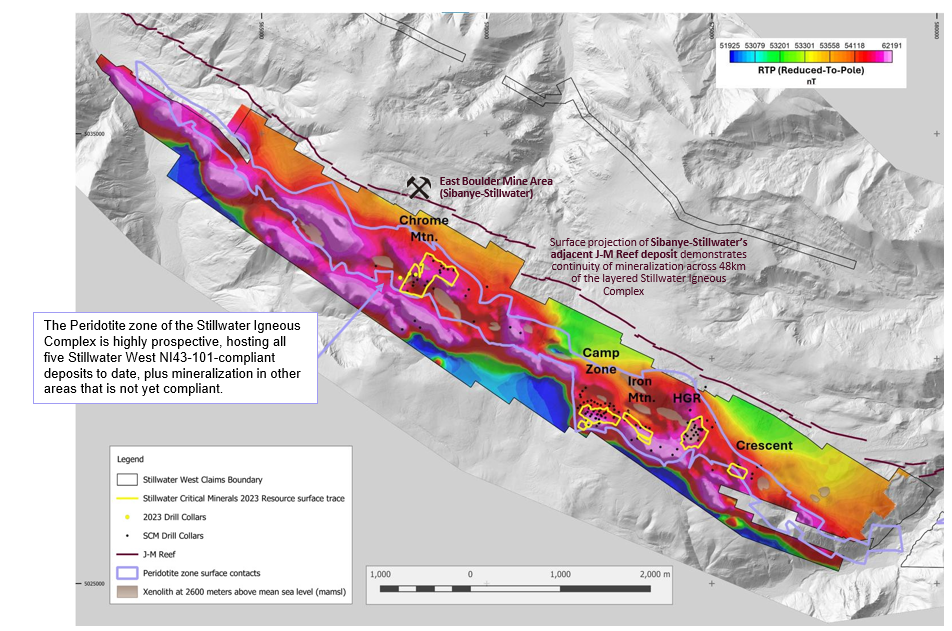
Reduced-to-Pole (RTP) magnetic data from the 2024 MobileMTm survey demonstrates:
- Highly magnetic anomalies are associated with the mafic-ultramafic rocks of the peridotite zone, and with iron formation outside of the peridotite zone.
- Near surface expression of less magnetic country rock xenoliths and structural offset are additional features highlighted by the high-resolution dataset.
Figure 1 – RTP MAGNETIC DATA FROM THE 2024 MMT GEOPHYSICAL SURVEY OVER TOPOGRAPHY WITH OUTLINES OF THE CURRENT DEPOSIT MODELS AND PERIDOTITE ZONE
STILLWATER WEST Ni-PGE-Cu-Co + Au PROJECT, Montana, USA
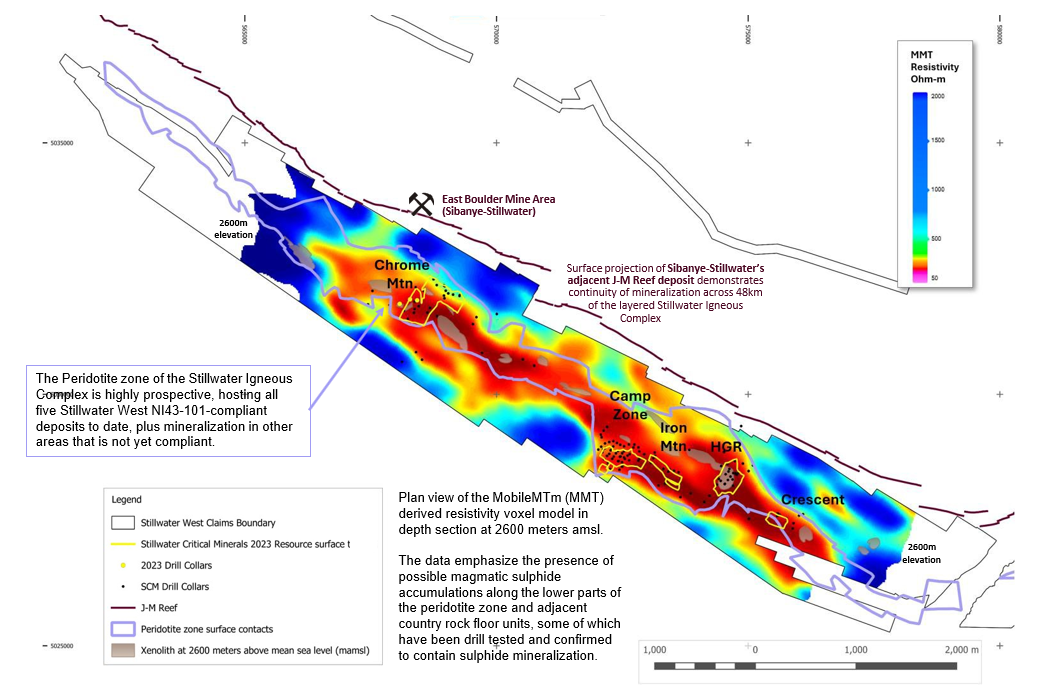
Figure 2 – DEPTH SECTION AT 2600 METERS ELEVATION SHOWING RESISTIVITY (CONDUCTIVITY) FROM THE 2024 MMT GEOPHYSICAL SURVEY WITH TRACE OUTLINES OF CURRENT DEPOSIT MODELS AND PERIDOTITE ZONE
STILLWATER WEST Ni-PGE-Cu-Co + Au PROJECT, Montana, USA
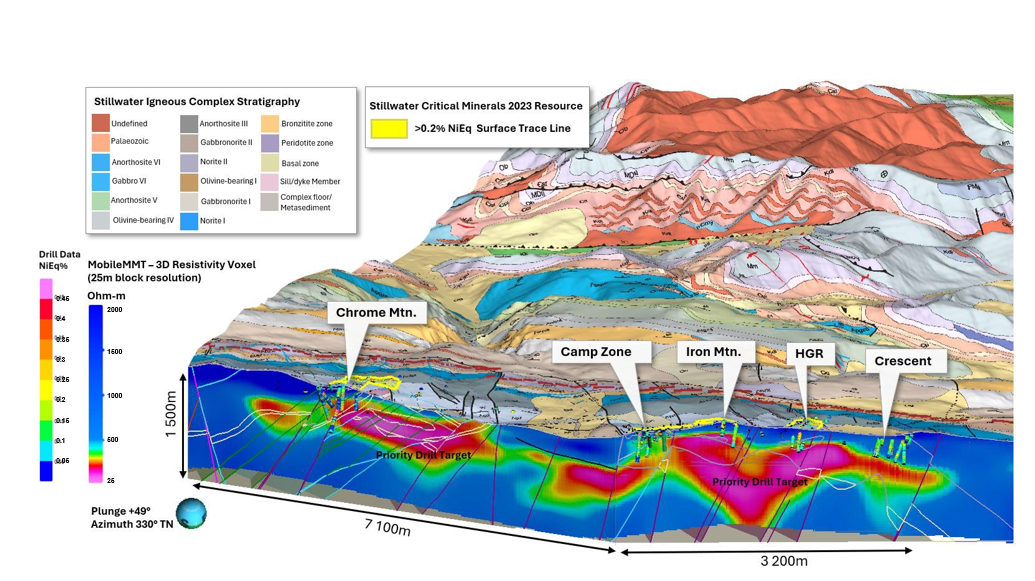
3D Apparent Resistivity voxel model derived from the 2024 MobileMTm survey. The dual face vertical section shows low resistivity anomalies (priority drill targets) in close proximity to the lower contact of the Peridotite zone, also confirming the orientations and offsets of major faults.
Figure 3 – LONG-SECTION SHOWING RESISTIVITY (CONDUCTIVITY) FROM THE 2024 MMT GEOPHYSICAL SURVEY WITH TRACE OUTLINES OF CURRENT DEPOSIT
MODELS ACROSS 10.3 KILOMETERS OF THE STILLWATER COMPLEX
STILLWATER WEST Ni-PGE-Cu-Co + Au PROJECT, Montana, USA
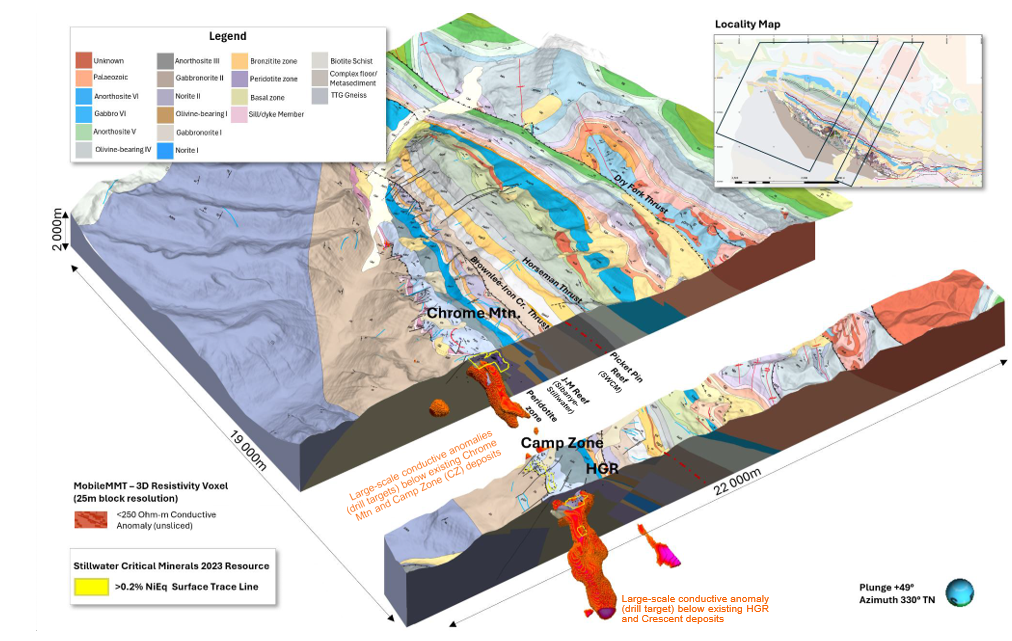
Figure 4 – CROSS-SECTION THROUGH THE LAYERED STRATIGRAPHY OF THE STILLWATER IGNEOUS COMPLEX AT THE CHROME AND IRON MOUNTAIN
DEPOSIT AREAS SHOWING LARGE-SCALE CONDUCTIVE ANOMALIES
STILLWATER WEST Ni-PGE-Cu-Co + Au PROJECT, Montana, USA
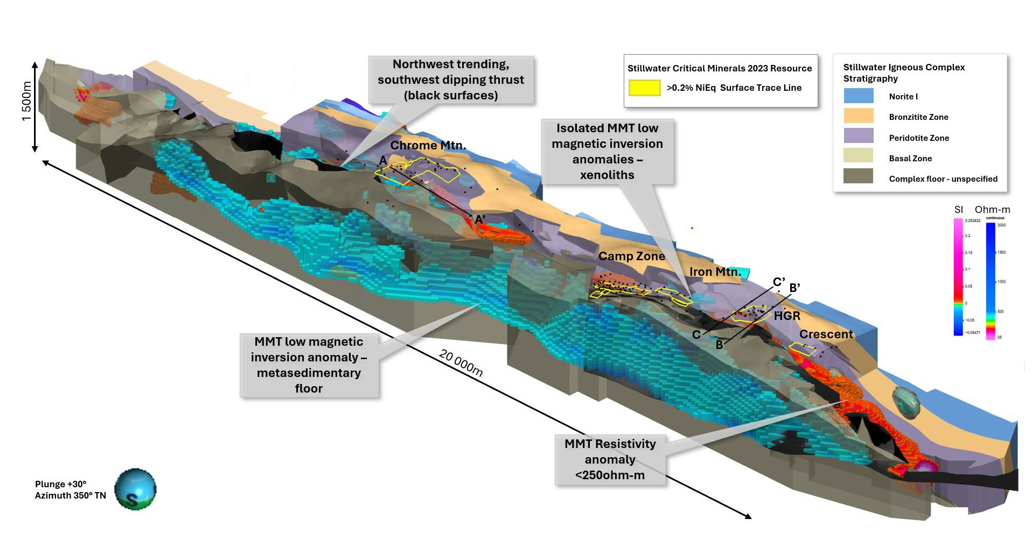
Magnetic inversion produced from the 2024 MobileMTm (‘MMT’) data shows the presence of extensive strike-parallel thrusts within the floor of the Stillwater Complex (shown in black). The low magnetic anomaly is attributed to intense alteration of the adjacent wall rocks of these structures . Isolated low magnetic anomalies are caused by country rock xenoliths (rafts) within the lower parts of the Peridotite zone, some of which have been confirmed in drill intercepts.
The highly magnetic iron formation, interbedded within the hornfels as part of the floor to the Stillwater complex, is confirmed by extensive highly magnetic anomalies below the floor contact of the complex. The geological model has been adjusted to account for the position and geometry of the floor contact based on interpretation of these anomalies. Refer to sections A-A’, B-B’, and C-C’ which show the low and highly magnetic anomalies and their correlation to the floor thrusts and stratigraphic contacts respectively.
Figure 5 – MAGNETIC INVERSION OF THE 2024 MMT GEOPHYSICAL SURVEY ACROSS 20 KM WITH SURFACE OUTLINES OF CURRENT DEPOSIT MODELS
STILLWATER WEST Ni-PGE-Cu-Co + Au PROJECT, Montana, USA
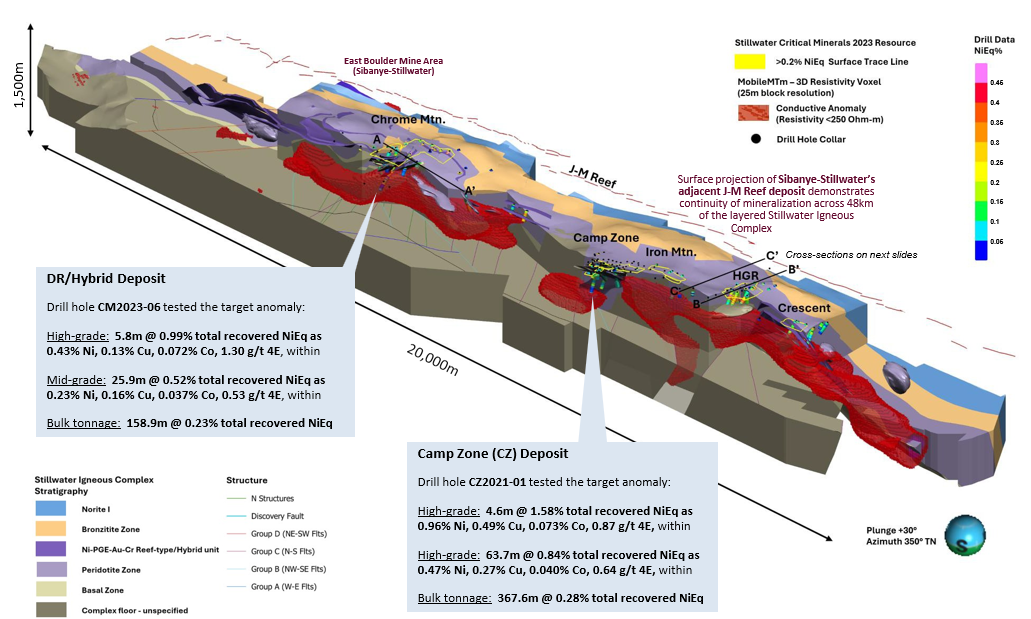
A multi-face strike section across the extent of the main claim block at Stillwater West. The strike extensive conductive anomaly derived from the 2024 MobileMTm survey (<250ohm-m resistivity) is shown and can be seen closely underlying the current drill limits within all the target resource areas.
Figure 6 – MULTI-FACE LONG-SECTION ACROSS 20 KM OF THE LOWER STILLWATER COMPLEX SHOWING MULTI-KILOMETER CONDUCTIVE ANOMALIES AND DRILL TESTS OF NEW TARGETS
STILLWATER WEST Ni-PGE-Cu-Co + Au PROJECT, Montana, USA
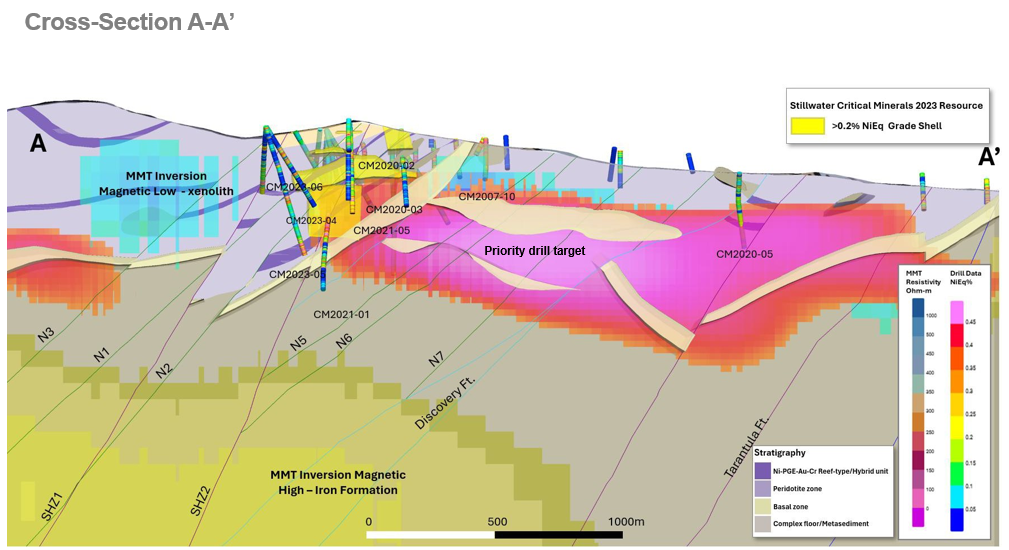
Strike section A-A’ due east of the 2023 MRE area at Chrome Mtn. A highly conductive zone can be seen proximal to the floor contact. The conductive anomaly may be attributed to semi-massive/massive magmatic sulphide which formed by entrapment between the country rock xenolith and floor rocks.
Figure 7 – CROSS-SECTION A-A’ SHOWING LARGE HIGH-LEVEL CONDUCTIVE TARGET AT CHROME MOUNTAIN DEPOSIT AREA
STILLWATER WEST Ni-PGE-Cu-Co + Au PROJECT, Montana, USA
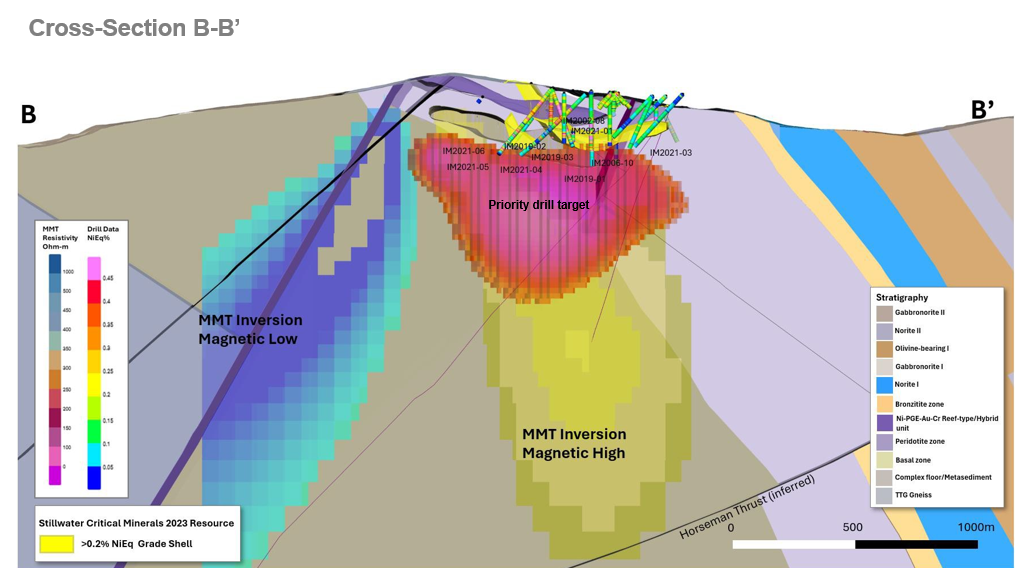
Figure 8 – CROSS-SECTION B-B’ SHOWING LARGE HIGH-LEVEL CONDUCTIVE TARGET AT THE HGR DEPOSIT AREA, IRON MOUNTAIN
STILLWATER WEST Ni-PGE-Cu-Co + Au PROJECT, Montana, USA
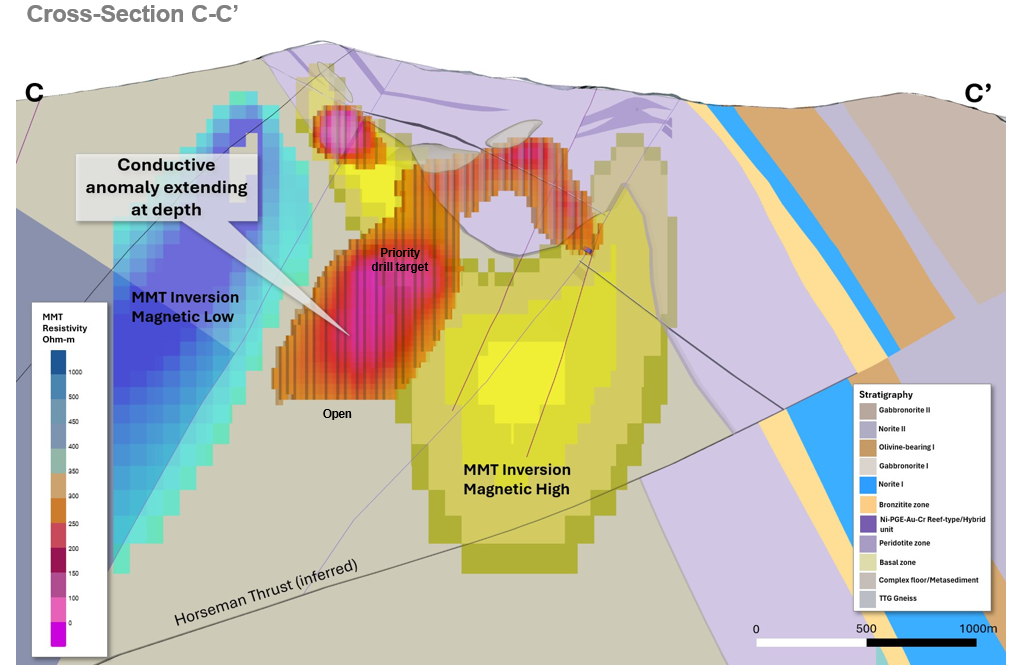
Figure 9 – CROSS-SECTION C-C’ SHOWING LARGE HIGH-LEVEL CONDUCTIVE
TARGET AT THE HGR DEPOSIT AREA, IRON MOUNTAIN
STILLWATER WEST Ni-PGE-Cu-Co + Au PROJECT, Montana, USA
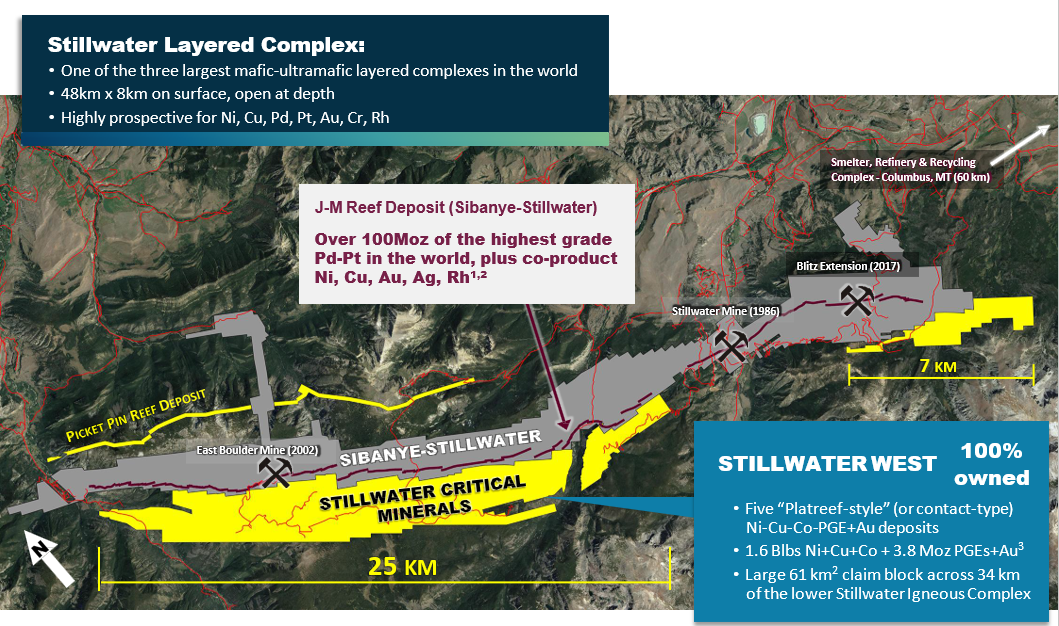
1: References to adjoining properties are for illustrative purposes only and are not necessarily indicative of the exploration potential, extent or nature of mineralization or potential future results of the Company’s projects.
2: Includes current reserves and resources, and over 15Moz of past production. Based on publicly disclosed production statistics of Sibanye-Stillwater including most recent CPR: https://www.sibanyestillwater.com/business/reserves-and-resources/
3: See news release January 25, 2023. Mineral Resources are reported at cut-off grades of 0.20% NiEq.
Figure 10 – STILLWATER DISTRICT – MINES, INFRASTRUCTURE, LAND STATUS
STILLWATER WEST Ni-PGE-Cu-Co + Au PROJECT, Montana, USA

1: References to adjoining properties are for illustrative purposes only and are not necessarily indicative of the exploration potential, extent or nature of mineralization or potential future results of the Company’s projects.
2: Based on publicly disclosed production statistics of Sibanye-Stillwater including most recent CPR: https://www.sibanyestillwater.com/business/reserves-and-resources/
Figure 11 – CROSS-SECTION THROUGH THE STILLWATER IGNEOUS COMPLEX
SHOWING STILLWATER WEST AND SIBANYE’S EAST BOULDER MINE COMPLEX
STILLWATER WEST Ni-PGE-Cu-Co + Au PROJECT, Montana, USA
SOURCE: Stillwater Critical Minerals Corp.
View the original press release on ACCESS Newswire





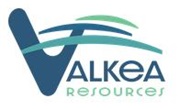






















Stillwater continues to grow the rainbows of colour and rare earth minerals within these Conductive targets. The time has never been better……